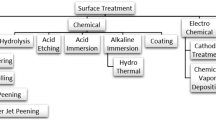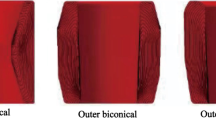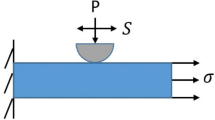Abstract
The objective of this study is to review and evaluate the applications of surface peening processes that can significantly contribute to surface property enhancement and prevent surface-induced failures. In the study, taking account of industrial applications, the current advantages, limitations, technological barriers and future prospects of peening technologies for industrial applications is assessed. Detailed explanations of the recent developments in the main components of peening processes are given. Factors such as peening media, peening process, component geometry, manufacturing method and mechanical properties of the base material are studied using experimental data. Developments in peening processes improved fatigue, corrosion and fretting behaviours of high performance components such as titanium alloy connecting rods for titanium alloy connecting rods for sports car. The results of the study conclude that peening processes have no geometry limitations and produce results that are usually economical.
Similar content being viewed by others
References
Azhari A, Schindler C, Li B (2013) Effect of waterjet peening on aluminum alloy 5005. Int J Adv Manuf Technol 67:785–795
Jinu GR, Sathiya P, Ravichandran G, Rathinam A (2009) Investigation of the fatigue behaviour of butt-welded joints treated by ultrasonic peening process and compared with fatigue life assessment standards. Int J Adv Manuf Technol 40:74–83
Kumar H, Singh S, Kumar P (2013) Modified shot peening process—a review. IJESET 5:12–19
Metal Improvement Company (2014) Shot peening. Metal Improvement Company web.http://www.metalimprovement.co.uk/controlled-shot-peening.html#section1. Accessed 20 March 2007
Fard SB, Guagliano M (2009) Effects of surfaces nanocrystallization induced by shot peening on material properties: a review. Frattura ed Integrità Strutturale 7:3–16. doi:10.3221/IGF-ESIS.07.01
Shaw MC (1972) New developments in grinding. Carnegie-Mellon University Press, Pittsburgh
Metallurgical Associates Inc (1999) Minutes. Metallurgical Associates Inc, Milwaukee
Metal Improvement Company (2005) Shot peening applications. Metal Improvement Company, NJ
Black JT, Kohser RA, DeGarmos (2008) Materials and processes in manufacturing. Wiley, USA
Shot peening overview. COMCO Web http://www.comcoinc.com/wp-content/uploads/2012/12/Shot-Peening-Overview.pdf. Accessed 21 March 2014
Shot peening applications. Metal Improvement Company web. Accessed 19 March 2007 http://www.metalimprovement.com//premium/PDF/greenbook_v9/english/Chapter%202.pdf
Chan CY, Lee WB, Wang H (2013) Enhancement of surface finish using water-miscible nano-cutting fluid in ultra-precision turning. Int J Mach Tool Manuf 73:62–70. doi:10.1016/j.ijmachtools.2013.06.006
Guernic YL (1988) Shot peening retards fretting. Metal lmprovement Company 11.nd conference on shot peening CETlM, Senlis
Higounenc O (2005) Correlation of shot peening parameters to surface characteristic. ICSP9 : SHOT PEENING, Montargis
Behal J (2004) life extension of fatigued steel specimens by shot peening. 3rd Youth Symposium on Experimental Solid Mechanics Web http://www.ysesm.ing.unibo.it/ysesm2004/Abstracts/Behal.pdf. Accessed 21 March 2014
Technical review, progress in the application of shot-peening technology for automotive engine components, Yamaha Motor Co., Ltd., 1998
How is shot peening intensity measured? Saranindustries Web. http://www.saranindustries.com/shot-peening/how-is-shot-peening-measured.asp. Accessed 21 March 2014
Mahagaonkar SB, Brahmankar PK, Seemikeri CY (2008) Effect of shot peening parameters on microhardness of AISI 1045 and 316L material: an analysis using design of experiment. Int J Adv Manuf Technol 38:563–574
Sara B, Ramin G, Guagliano M (2012) On the shot peening surface coverage and its assessment by means of finite element simulation: a critical review and some original developments. Appl Surf Sci 259:186–194
Leon FP (2001) Determination of the coverage of shot peened surfaces. In Brebbia C (ed) Surface treatment V: computer methods and experimental measurements, Wessex Inst Technol, SEVILLE pp 323–332
Meguid S (1991) Effect of partial-coverage upon the fatigue fracture-behavior of peened components. Fatigue Fract Eng M 14:515–530
Ohara P (1984) A note on the use of dyescan tracers as a quality-control tool for coverage determination in controlled shot-peening. J Mech Work Technol 10:187–192
Zheng C, Sun S, Ji Z, Wang W, Liu J (2010) Numerical simulation and experimentation of micro scale laser bulge forming. Int J Mach Tool Manuf 50:1048–1056
Wang X, Du D, Zhang H, Shen Z, Liu H, Zhou J, Liu H, Hu Y, Gu C (2013) Investigation of microscale laser dynamic flexible forming process—simulation and experiment. Int J Mach Tool Manuf 67:8–17
Ulutan D, Ozel T (2011) Machining induced surface integrity in titanium and nickel alloys: a review. Int J Mach Tool Manuf 51:250–280
Trškoa L, Boku O, Novy´ F, Guagliano M (2014) Effect of severe shot peening on ultra-high-cycle fatigue of a low-alloy steel. Mater Design 57:103–113
WPC treatment (2014) Reduced friction. Metal surface treatment for motor sports web. http://www.wpctreatment.com. Accessed 25 March 2014
Marsh R (2011), Experimental analysis of oil based cavitation peening in air. Dissertation, Georgia Institute of Technology
Deguchi D, Mouri M, Hara J, Kano D, Shimoda T, Inamura F, Fukuoka T, Koshio K (2012) Fatigue strength improvement for ship structures by ultrasonic peening. J MAR SCI TECHNOL17:360–369
Hirano S, Hamasaki K, Okimura K, Maintenance activities for Alloy 600 in PWR plants. E-J Adv Maint l2:1–3
Todaka Y, Umemoto M, Tsuchiya K (2005) Comparison of nanocrystalline surface layer in steels formed by air blast and ultrasonic shot peening. Mater Trans 45:376–379
Toyo Seiko Co. Ltd. (2014)Ultrasonic shot peening. Toyo Seiko Co Web. www.toyoseiko.co.jp
Yoda M, Newton B (2008) Underwater laser peening. Welding and Repair Technology for Power Plants Eighth International EPRI Conference. Fort Myers, Florida
Im J, Grandhi RV, Ro Y (2012) Residual stress behaviours induced by laser peening along the edge of curved models. J Mech Sci Technol 26:3943–3952
Toparlı MB, Fitzpatrick ME, Gungor S (2013) Improvement of the contour method for measurement of near-surface residual stresses from laser peening. Exp Mech 53:1705–1718
Satihyajith S, Kalainathan S, Swaroop S (2013) Laser peening without coating on aluminium alloy Al-6061-T6 using low energy Nd:YAG laser. Opt Laser Technol 45:389–394
Maawad E, Sano Y, Wagner L, Brookmeier HG, Genzel C (2012) Investigation of laser shock peening effects on residual stress state and fatigue performance of titanium alloys. Mater Sci Eng:A 536:82–91
Soyama H (2004) Introduction of compressive residual stress using a cavitating jet in air. J Eng Mater Technol Trans 126:123–128
Soyama H, Homma K (2004) Cavitation peening by using cavitating jet in air. 3rd Youth Symposium on Experimental Solid Mechanics Web. http://www.ysesm.ing.unibo.it/ysesm2004/Abstracts/Behal.pdf. Accessed 21 March 2014
Mitsubishi Havy Industries Ltd (2014) Water jet peening technology for preventing stress corrosion cracking by using cavitations. Mitsubishi Heavy Industries web. http://www.jsm.or.jp/ejam/Vol.1.No.2/NT/7/article.html. Accessed 25 March 2014
Ormond Inc (20014) Cavitation peening. Ormond Inc Web. http://www.ormondllc.com/#cavitation_peening
Gao Y, Wu B, Liu Z, Zhou Y, Shen N, Ding H (2013) Ultrasonic cavitation peening of stainless steel and nickel alloy. J Manuf Sci Eng 136:1–5. doi:10.1115/1.4025756
Grinspan AS, Gnanamoorthy R (XXXX) Development of a novel oil cavitation jet peening system and cavitation jet erosion in aluminum alloy, AA 6063-T6. J. Fluids Eng 131:1–6. doi:10.1115/1.3129134
Yildirim HC, Marquis GB (2013) Fatigue strength improvement factors for high strength steel welded joints treated by high frequency mechanical impact. Int J Fatigue. doi:10.1016/j.ijfatigue.2012.05.002
Lechner C, Bleicher F, Habersohn C, Bauer C, Goessinger S (2012) The use of machine hammer peening technology for smoothening and structuring of surfaces. In: Katalinic B (ed) Proceedings of the 23rd International DAAAM Symposium. DAAAM International, Vienna, pp 331–336
http://accurapuls.de/Verfahrensbeschreibung%20_englisch.html, (2010). Website accurapuls GmbH, Accessed on: 2012-07-02
Bleicher F, Lechner C, Habersohn C, Kozeschnik E, Adjassoho B, Kaminski H (2012) Mechanism of surface modification using machine hammer peening technology. CIRP Ann Manuf Technol 61:375–378
Tenaglia RD, Lahrman DE (2003) Preventing fatigue failures with laser peening. AMPTIAC 7:3–7
Yu H, Dong JL, Yoo DH, Shin K (2009) Effect of ultrasonic and air blast shot peening on the microstructural. J Korean Phys Soc 54:1161–1166
Author information
Authors and Affiliations
Corresponding author
Rights and permissions
About this article
Cite this article
Kulekci, M.K., Esme, U. Critical analysis of processes and apparatus for industrial surface peening technologies. Int J Adv Manuf Technol 74, 1551–1565 (2014). https://doi.org/10.1007/s00170-014-6088-9
Received:
Accepted:
Published:
Issue Date:
DOI: https://doi.org/10.1007/s00170-014-6088-9




